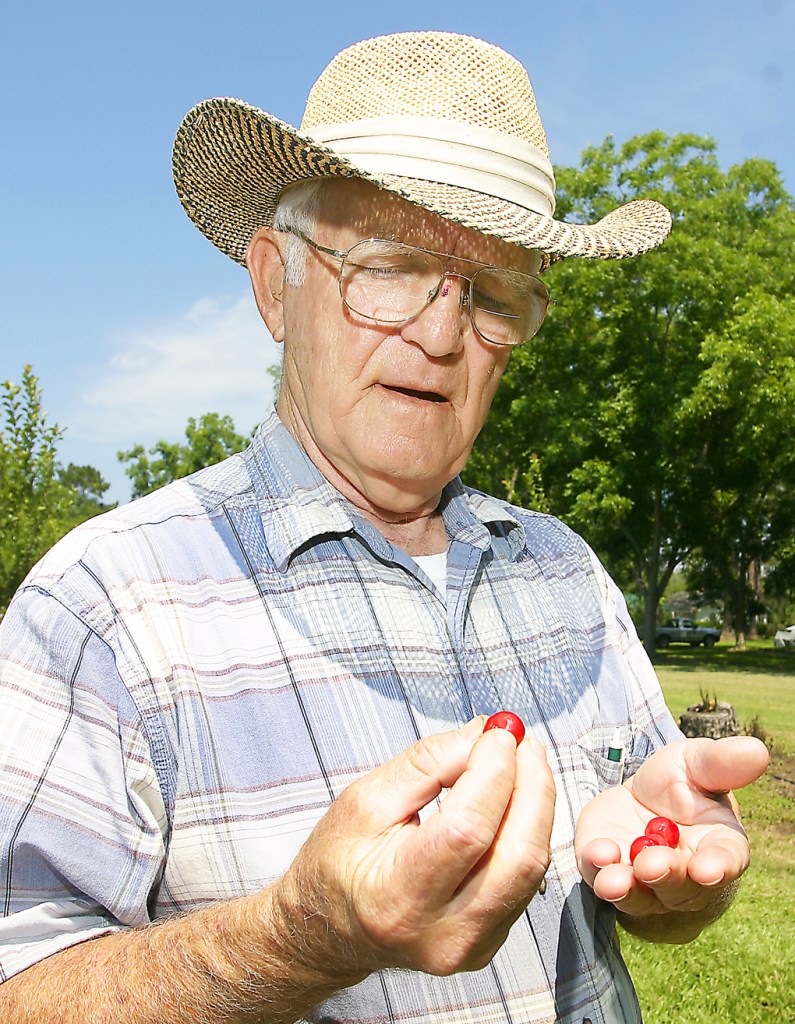Couple grows rare berries to stay busy
Published 2:24 am Sunday, June 22, 2008

- Pat Gallagher/The Valdosta Daily Times
LANIER COUNTY — A Mayhaw is a juicy, ripe, often bright red berry that grows on a Hawthorne tree and gets its name because it’s harvested in May from the Hawthorne… Mayhaw. It makes amazingly delicious jellies, syrup and even wine. It grows mostly in the Southeastern U.S.
Jimmy and Emma Moore, who live just over the county line in Lanier north of the Moody AFB bombing range, learned about Mayhaws several years ago. The retired couple have kept busy tending their own orchard of Hawthorne trees in a beautiful quiet setting on a nice patch of land maybe two miles from Bemiss Road, if that.
The Moores combined their first names – Jimmy and Emma – into “Jem’s” to create their own moniker for their berry business. Jem’s Mayhaws sells grafted trees to those who want to have a Mayhaw berry tree or three in their yard or start their own orchard. They sell some of the most delicious, homemade jelly and syrup made from Mayhaw berries you’d ever want to taste.
They make juice from the berries too, but although they can make some fairly potent wine from the fruit, they dare not sell it because they’re not licensed to do so.
The Mayhaw is known for producing a sweet but tangy, tart fruit that, except for that tartness, produces a very sweet jelly similar to an apple jelly. (A few samples on a cracker made it hard to put down the spreading knife and pick up the pen to continue this interview. We’re talking ‘delicious’ here.)
The syrup made from Mayhaws can be used like any other syrup, on pancakes, waffles or biscuits. “We have a daughter who loves to put the syrup on ham,” Emma Moore said.
Business got so good, the Moores installed a large kitchen in a building just behind their modest home, which sits along the dirt-gravel road on a pond surrounded by a beautiful green lawn and of course, rows of varying species of Hawthorne trees.
The kitchen is a state-inspected and approved kitchen for producing their Mayhaw products.
“I got into this in 1994, after I retired from the PCA mill in Clyattville after 31 years there,” Jimmy Moore said. “A friend of mine over in Hahira started growing some, so I got into it. I tell people I got into it because so little is known about Mayhaws that no one could tell me how to do it,” he said with a chuckle.
“You know, in agriculture, any farmer will tell you someone is always telling you how to grow a crop, when really, the farmer doing the growing usually knows best.”
The Moores made their own jelly from the berries and began to think that this might be a good side business to keep them busy while they enjoy their retirement years. Now the business has grown, by word of mouth, to the point that it’s almost made them busier than they wish to be, Moore said.
“I found out there’s not much known about producing Mayhaws in a commercial setting. So this has been an educational process,” he said. “But I’m not sure how long we can keep this up. We’ve been doing it for 14 years now. We started out small, but have built up our business considerably.”
Mayhaws, Moore explains, are found in southern states in the Gulf of Mexico region, mainly in Texas, Louisiana and Georgia, but have been known to be found in Georgia and up to North Carolina and South Carolina.
He’s networked with the few Mayhaw growers around the region, and has become particularly connected to the Louisiana growers. The Louisiana bunch has organized and formed their own Mayhaw growers association so they can apply for assistance from state agricultural assistance sources like the local extension office.
The Louisiana effort has been so successful that Mayhaw jelly is the state jelly there, Moore noted.
He pointed to three rows of hybrid Mayhaws developed by a Louisiana grower he’s come to know. One is known as the “Red Majesty.” Another is dubbed as the “GG” breed. There’s the “Georgia Giant,” the “Texas Star,” “Big jems,” a “G5” and a “G2,” about 10 primary varieties of Mayhaw-producing Hawthorne trees, Moore explained.
He said he grows mostly the western variety of Hawthornes because they produce larger berries. The couple tends about 250 trees on their land. They keep a deer fence up to ward off those berry-eating mischiefs, and take other standard precautions with insecticides and disease prevention treatments to protect their crop.
The Hawthorne tree grows to about 35 feet in height. New plantings are done in January and produce berries that can be harvested in late April through May. Like any other berry grower, Mayhaw farmers have to worry about a late freeze that could destroy a crop as the berries reach their later growth in April, Moore said.
“We got hit by the late freeze last year. We lost probably half of our crop. But we’ve come back strong this year,” Moore said.
The Moores have developed quite a reputation for the quality of their products in a sort of underground network of Mayhaw fans throughout the Southeast.
They sell their products at three regional arts and crafts shows, where they learned that providing a sample to folks who haven’t a clue what a Mayhaw is was the secret to drawing in customers.
“One fellow in a booth next to ours noted how we would probably sell out, thanks to the samples we provided,” Moore noted.
They ship their products to customers in North Georgia, Florida and Texas, and sell to locals who’ve found out about their products as the word spread. Thanksgiving and Christmas usually draw many requests for jellies and syrups, so the Moores developed gift packages to accommodate the holiday buyers.
“It works kind of like this. One fellow bought a case of syrup and handed them out to friends and family at Thanksgiving. So then those people who received the gifts want to know where he got this, and they then call us up and place Christmas orders for more,” Moore said.
The Moores received a particularly memorable compliment one year during the Flatlanders Celebration in Lakeland. A woman from Colquitt (north of Bainbridge) bought a case of the Moore’s Mayhaw jelly. Turns out Colquitt has its own Mayhaw Festival. The woman called later to get more of the Jem’s brand.
“The next year, she called and said, ‘Do you have Mayhaw jelly?’ And we said yes,” Emma said. “She said ‘I want two cases and we’re coming for it.’ They drove all the way from Colquitt to get it. She said no one can make Mayhaw jelly like y’all can.’ Coming from someone who lives in a town where they have a Mayhaw festival, we thought that was probably the best compliment we could get.”
The secret to producing a quality Mayhaw jelly is in the patience it takes to manage the tedious process, the Moores explain. They don’t use any unnatural additives, but do throw in some pectin to help the jelly gel. If a batch doesn’t gel right in the jar, they throw it out,”
“We take great pride in making a quality jelly. We don’t cut corners and won’t just sell anything,” Moore said. “If you see any Mayhaw jelly in a local grocery store, and you might in some places, it will not be as good as ours because it’s usually cut some way or it’s made with food coloring or other additives we will not use.”
Moore added that he doesn’t mind anyone who says they make a better Mayhaw jelly as long as they really have made the extra effort to do it.
“I hope it’s a good quality jelly so it doesn’t give Mayhaws a bad name,” he said.
For Mayhaws to continue to grow in popularity, or to catch in Georgia as another key berry crop, young farmers will have to get involved in its production, Moore suspects.
“We need young people to get into it because they would stay in it a long time,” he said. “But it is a lot of hard work and a lot of people don’t want to do the hard work any more.”
He deflated another myth surrounding Hawthorne trees.
“A lot of people think they can only grow in swampy areas, but they will grow anywhere,” he said. “We sell the trees to people who just want a fruit tree in their yard. And we do get a few who buy several to start their own private orchards.”
Potential Mayhaw jelly/syrup fans can call the Moores at 229-244-7547 to place an order.





